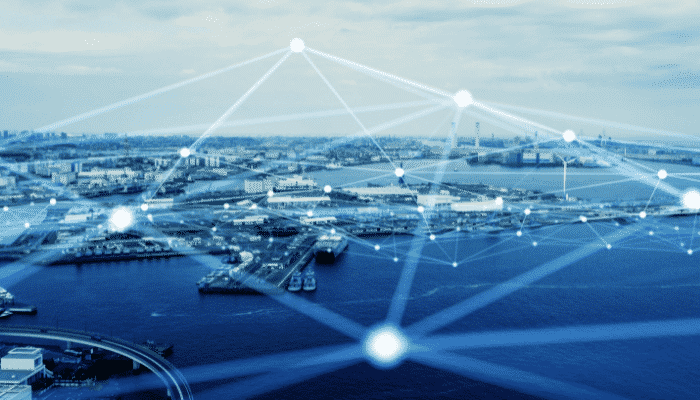Understanding Internet of Things (IoT) in Logistics
A concept that came about in the 1980s, the IoT or Internet of Things is all about integrating or interconnecting several devices over the internet and using them to perform actions better and smarter. To achieve this, such devices have to be network-enabled.
They are equipped with sophisticated sensors that can collect information and semiconductor chips that can send as well as receive data over the internet. Good internet connectivity is crucial for using IoT technology.
Typically, the internet of things refers to connecting physical devices over the internet and using their combined output to perform actions. Examples of IoT technology can be found in home automation, process automation in industries, the healthcare and fitness industry, etc.
The terms automation and IoT are often confused with each other. In simple words, IoT is used to achieve automation.
How does the concept of IoT apply to the logistics field? Modern logistics of goods involves the execution of several procedures. These procedures, most of which are interlinked, help in the ordering, procurement, transport, receipt, and redistribution of goods.
A successful logistics operation should combine and execute the procedures smoothly for goods to reach the end customer in good condition, as planned, and on time.
Some of the areas in logistics where the IoT has brought about revolutionary changes are given here.

Inventory Management
Gone are those days when items are placed on order from the supplier just as it is running low at the warehouse. IoT has made it possible for stocks to be ordered based on several pre-set parameters. Similarly, overstock situations are alerted in advance for the relevant teams to take the necessary sales ramp-up actions.
Goods are tracked by the inventory system from the moment an order is placed with the supplier and followed through until it is received at the warehouse and later sold to a customer.
Automatic sales forecasting and purchase order placements are common in many industries. It does away with the need for manual calculations. Such an order is usually confirmed by the system and forwarded automatically to the respective supplier and transport agent. In some cases, it may be vetted by a manager before sending.
Besides this, regular and real-time communication between the stakeholders such as the seller, buyer, and the transporter regarding the stock situation is made possible through the inventory management system.
Control of Transport Container and the Warehouse Environment
Modern warehouses are strictly regulated to achieve the perfect environment for the receipt, storage, and distribution of goods. Goods that are sensitive to temperature and humidity fluctuations have to be stored under the prescribed conditions to preserve their quality.
Temperature-controlled warehouses under the IoT are programmed in such a way that the pre-set temperature and humidity required for the goods being stored are maintained, based on the type and quantity of goods. These settings may vary between different sections of the warehouse depending on the goods stored in each section.
Certain gases such as carbon dioxide (CO2) or ethylene (C2H4) are used to speed up the ripening of fruits even while it is in transit in special containers.
The concentration and circulation of the gas within such a container have to be maintained optimally to achieve the correct ripening. This process, whether it is done inside a container or during storage of the fruits inside a warehouse is monitored and maintained using IoT technology.
Self-driving and self-guided vehicles help improve speed and reduce inaccuracies in stacking and picking to a great extent.
Efficient Utilization of Warehouse Space
A warehouse with storage at the maximum, while being a healthy trend for the warehouse owner can also be his worst nightmare. It may leave him with no capacity for catering to the storage requirements of other regular customers. It may also come in the way of the expansion of his current business.
Space optimization helps to manage the existing space to accommodate inventory. IoT helps to optimize space at warehouses, container yards, and freight stations based on trends and historic patterns. It provides real-time data on empty slots for better positioning of containers or stocks.
Dark Warehouses
Goods that are stored in dark warehouses are received, moved, sorted, and packed by automated machines or robots. There is minimum human intervention here.
Right from receiving the goods at the warehouse to identifying, retrieving, sorting, packaging and labelling, to loading them for redistribution the whole operations are managed by programmed machines.
Such smart warehouses cater to a variety of specialized goods and are seen as the perfect solution to labour shortages, maintaining stock accuracy, and hygiene of the goods.
Though setting up a dark warehouse can be very expensive owing to the technology and hardware involved, it can result in cost reduction in the long run.
IoT and Data Analysis
A robust logistics operation is hinged on reliable and real-time data. Data analysis helps in the study of processes and in identifying areas for their improvement. Actions based on such studies can reduce human errors, breakdowns, and the overall downtime of material handling equipment (MHE).
Dissemination of timely and required data and documentation to stakeholders is also achieved through the integration of systems. IoT, through the blockchain system, helps in exchanging secure and tamper-proof digital documentation such as in shipping bills of lading, etc. between the different parties.
Robotics in Delivery of Goods
Drones are robots that can fly and be programmed to do certain tasks such as photography, delivery of packages, etc.
Delivery of packages using drones may be in the initial stages across the world. Amazon through its Prime Air operations is a pioneer in this field with trial services in select US cities since 2019. Prime Air promises quick delivery of individual packages to its customers, using drones.
Drone delivery can be very useful in situations like natural calamities, pandemics, etc.
Concerns on Internet of Things
While IoT technology is a very useful tool in making the workplace dynamic, there are several concerns when it comes to data privacy and breach of security.
Data collected from the IoT devices are normally stored in storage servers of large capacity or on the data cloud. Several billions of devices are connected to the internet and the data, their ‘habits’ or ‘routines’ are available in storage servers or data clouds.
Since the technology involves the transfer and processing of large quantities of data, it is prone to data theft and security breaches. These concerns are currently being addressed through governmental regulations and guidelines.
You might also like to read:
- What is Shipped On Board in Logistics?
- Packing and Packaging in Logistics
- What is Inbound and Outbound Logistics?
- A Career in Logistics – A Detailed Guide
- Guide to Cold Chain Logistics: Things You Must Know
Disclaimer: The authors’ views expressed in this article do not necessarily reflect the views of Marine Insight. Data and charts, if used, in the article have been sourced from available information and have not been authenticated by any statutory authority. The author and Marine Insight do not claim it to be accurate nor accept any responsibility for the same. The views constitute only the opinions and do not constitute any guidelines or recommendations on any course of action to be followed by the reader.
Do you have info to share with us ? Suggest a correction

About Author
Hari Menon is a Freelance writer with close to 20 years of professional experience in Logistics, Warehousing, Supply chain, and Contracts administration. An avid fitness freak, and bibliophile, he loves travelling too.
Latest Maritime law Articles You Would Like:
Latest News
- What is the Purpose of DG Shipping?
- What are Logistics Risks?
- How Port and Terminal Operators Can Control Emissions?
- Minimum Quantity Commitment (MQC) and Liquidated Damages in Container Shipping: Concept and Relevance
- MARPOL (The International Convention for Prevention of Marine Pollution For Ships): The Ultimate Guide
- The Ultimate Shipping Container Dimensions Guide
Subscribe To Our Newsletters
By subscribing, you agree to our Privacy Policy and may receive occasional deal communications; you can unsubscribe anytime.















